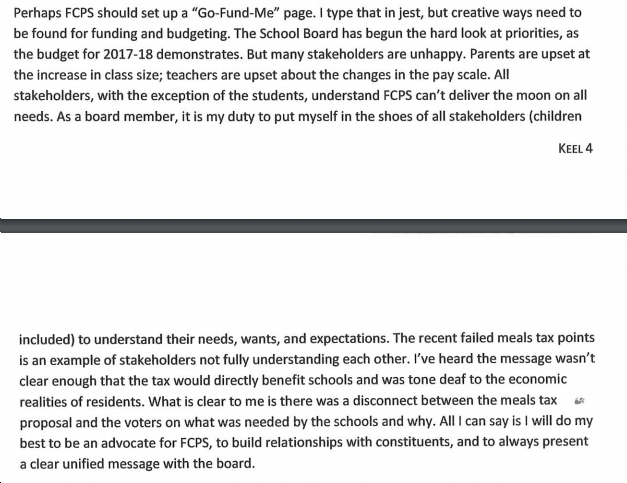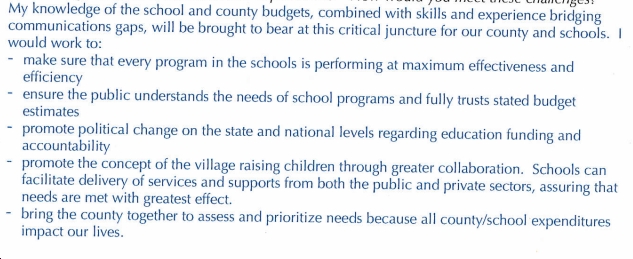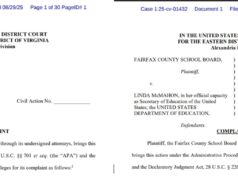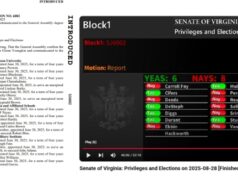The following are responses to the Fairfax County Democratic Committee (FCDC)’s questionnaire from the eight candidates for the Fairfax County Public School (FCPS) Board’s vacant, at-large seat. I’ll post the responses in random order. The candidates are, in alphabetical order: George Becerra, Marianna Du Bosq, Carolyn Hendler, Shaista Keating, Stacia Keel, Karen Keys-Gamarra, Michele Menapace and Abrar Omeish. Here are their responses to question #8 (“The political & economic realities of Fairfax County today are challenging and cannot be dismissed: the chances of increased support from the state or federal government are practically nil; the numbers of students, especially those with greater educational needs, are rising; demand for government services that impact our quality of life is constant; citizens expect top-quality schools which are a key driver of high property values; all county facilities—schools, libraries, parts, offices—require maintenance and operational upkeep; all public employees deserve living wages; and local property taxes simply can’t raise enough revenue to meet needs or expectations. How would you meet these challenges?”) of the eight-question FCDC Q & A. I’ll post the other Qs & As in separate posts. Note that FCDC will hold its meeting to endorse a candidate for this position on Friday, June 23rd, 7pm at the Fairfax County Government Center.
Marianna Du Bosq
I know firsthand that budget formulation is tough. I have been responsible for overseeing and leading the $60 billion resource allocation process at the Department of Homeland Security. One of my greatest lessons learned from my experience in financial management is that when dealing with multiple demands, budget principles and priorities must be identified. Funds should be aligned according to those priorities. They can help guide 1) the analysis of fiscal trade-offs and 2) the decision-making process. FCPS should set student achievement as its guiding principle. With student achievement as the driver, the FCPS school board can create specific resource allocation decisions that consider the total value created for our students.
As a board member, I would start of the budget formulation by leveraging the FCPS Strategic Plan and its four “Ignite” goals to inform the process. I would work closely with our Superintendent to prioritize funding enhancements and offsets. In addition, I plan to intentionally collaborate with and listen to key constituent groups through the county and use their input as a data source to inform the decision making process. To maintain accountability, I would ensure evaluations are conducted to determine if taxpayers’ dollars are well spent
Stacia Keel

Michele Menapace

Abrar Omeish
–Respecting expert recommendations and advocacy groups on needed class-size caps, teacher compensation (in a variety of ways), facility needs
–Compiling (or at least beginning to) an alumni network for former/future students who greatly benefited/where heavily involved in FCPS for a future donor base (e.g. student government, athletes, honor society members); contacting very wealthy alumni of the school system
–Potentially identifying millionaire (and beyond) parents of current students as well
–Corporate sponsorships of particular programs; this can support the portrait of the graduate and new technology while working with budgetary limitations; sponsors could include technology companies and wealthy contractors with existing pro bono/community sponsorship projects (e.g. Google, Microsoft, Booz Allen, Northrop Grumman); particularly likely if parents
–Exporting particular services like tutoring and counseling to existing non-profit organizations that do the work and that have the expertise from grassroots relationships with counselor/mentor follow up
–An exploration of investment opportunities, utilization of current assets for services/as property
–As a later initiative (since the meals tax just passed), an emission (Carbon) tax or “sin tax”- These are ways to teach students environmental stewardship/healthy habits while raising crucial funds
–Adjusting school standards (environment, equity, and performance) to qualify for federal grants and allowances from various nonprofit organizations
Shaista Keating
We cannot abandon our fundamental commitment to education. Spending on education is not just spending; it’s an investment in our children and in our future.
I will lead the School Board to think more creatively about funding. Yes, we must fight (on multiple avenues) for better funding from the federal government and from Richmond, whose diminishing share of K-12 education in FCPS is shameful. I know I can bring people together to fight for education, the same way we brought an army of parents to fight for Full Day Kindergarten and Fully Fund Fairfax County Public Schools.
But we must also do better among the many businesses and alumni who would support FCPS with vigor if only they were asked. As someone whose work has bridged the gap between the private and public sectors, I know how to pursue new partnerships so we are working better together to invest in our future.
At the same time, our School Board always must work to do more with less. That is simply the reality. In my career at Accenture, I worked with Fortune 500 companies to “unlock” value for shareholders. I know we can improve and streamline the way we do things, to stretch our dollars further.
Karen Keys-Gamarra
I support the position in the School Board’s legislative program, which calls for granting taxing authority to elected school boards. This change would align authority with responsibility, and convert School Board members from lobbyists to decision-makers with respect to school funding. We should also work to encourage greater dialogue between the school board and the Board of Supervisors, as well as, state officials who impact budgetary decisions.
George Becerra
The Fairfax County Equitable Growth Profile study showed that income inequality caused GDP to be $26.2 billion lower in 2012. Having equity across the system would have allowed for greater investment in our community. The cost of inequity will continue to rise as long as this income discrepancy is not addressed. The One Fairfax resolution is one way to begin to address this need for equity. George knew that the meals tax would not be a
silver bullet to fix current funding gaps after years of underfunding our Standards of Quality by the state. Possibilities for other funding streams might include Technology Bonds, Child Investment Tax, and changes to the BPOL fees. Because our schools are the largest attractor of businesses to the region, we must encourage the Board of Supervisors to levy business taxes that are equal to surrounding jurisdictions. Another way to address the budget challenge would be to identify savings through strict program evaluation and attention to zero-based budgeting.
Carolyn Hendler
The school board must continue to rise to the challenges posed by the budget constraints and economic realities of Fairfax County. Decreasing the amount of money spent per student isn’t the only way to be fiscally responsible. The budget should be allocated so that funds are utilized to maximize their impact on student learning such as decreasing class size, increasing kindergarten readiness programs and attracting and retaining
exceptional teachers. In addition, all available grants should be aggressively pursued. Schools should be encouraged to increase the number of partnerships with local businesses. Top quality schools are the key driver of high property values. It should be a priority to fund schools adequately as quality schools benefit all citizens regardless of whether they have currently have children in public school.














